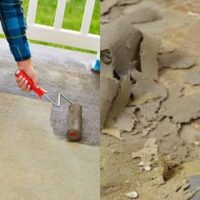Does paint dry darker or lighter from the color swatch? It is the most common question that asks every homeowner who wants to paint any surface.
The paint does not dry dark or light when it dries. It comes in its true colors after drying. But, the other ENVIRONMENTAL FACTORS decide or influence that the paint color is darker or lighter.
And the light refraction and absorbance may also affect the color. Like, the walls with gloss paint look darker because it reflects the light. While the flat paint makes a lighter look due to absorbent quality.
So, paint maintains its original color but, other surrounding factors will change the looks.
Does The Paint Dry Darker Or Lighter?
As discussed at the start, that does not dry dark, or light. Many peoples paint the wall and immediately said that this is not the color that I buy or I want.
They forget one thing that the freshly painted wall is wet. The wet paint coat has solvents like water or oil, and the painting looks darker. But, when the paint dries, the solvents generally evaporate completely. Now the original color of the finish appears.
The pigments are the original colors of dry paint that they take. The different pigments can absorb and reflect light to get a primary color.
Every wetting thing gives a darker shade due to solvents. Achieved its original color like paints When it is dried by evaporation. The answer to all questions usually depends on right and colored conditions.
1. Environmental Factors
Paint Surroundings:
The first factor is surrounding walls and objects. When you applying to the room ceiling or wall, see the surrounding area.
If the surroundings are lighter, it looks darker automatically. It looks lighter if the other walls have a darker painting.
For example, If you want some changes in the bedroom. Firstly, you need to change the paint. The painted walls are off-white but, you want one side with creamy shade. When you see these two colors in the shop, the difference is not much noticeable.
When applied in the room’s the one side is dark because the surrounding shades are lighter.
Sheen affect:
It is the type of finish that decides the colors. The paint refracts and blocks the light will be based on this factor. The surface’s appearance mainly depending on this prime factor.
Let you explain this factor. If you use green, the type affects the darker nature. They are allowed to choose the option according to conditions.
Light:
The amount and type of light affect less or more. The natural, dark LED, fluorescent, and halogen lighter lights alter their paint color. Some lightening casts the yellow and blue tones. It is a prospective method to select according to the room’s lighting.
Old paint:
Old paint influences the shade. Like, you have gray and old paint. The pigments are fading with time. Slowly, all the pigments are faded, and it looks lighter.
When you paint the wall with new paint of the same shade and color, the new one looks dark. It is just because of faded pigments.
What Are The Types Of Paint Finishes?
The types tell that that paint after application looking in which shades. Such as:
Flat/Matte:
The flat absorb more than other gloss paints. It is well suited on textured areas where absorbance hides stains and a lot of marks. No gloss present blocks the light.
When dry, the painting surface will become dark and might help to cover dirty things.
The flat is not suitable for the bathroom and other humid places. The moisture slightly damage. Therefore, it makes for dry regions due to these reasons.
Gloss:
The gloss reflects the lights and seems lighter. It gives reflective shine and acts as a barrier between pigment and the environment. It works effectively in high humidity areas. It did a great job in bright areas. When dry, it gives a dark appearance.
Satin and eggshell dry paint:
It is intermediate between flat and glosses finish. It contains 40% gloss and 15% flat paint. The dirty eggshell is wiped with a wet cloth smoothly. There is no problem with leaving marks with a little touch.
It is a better step from previous items to takes a clean layer. It is semigloss and comes for texture garage paintings.
FAQs
Is exterior dry paint darker than interior?
The above information tells us that typically the dry leaves shading or tinting according to the environment. The outside also faces the challenge of fast UV lights that directly fall.
Due to this factor, you can observe a small difference from than expected value. It indicated other environmental factors.
Do multiple coats darker the dry paint?
No, the second coat never makes it dark. The color is always the same as on the first try. It dries in some time, wait for hours to check the top quality product. You can check the surfactant on the paper. Prepare samples according to the base guide to check the quality.
The acrylic and latex with at least medium primer go smoothly under several environmental factors. The best way is that not left the dry paint for a long period after mixing. Plus, the complete colored range ensures these three types that enough to explain everything. If you can apply the acrylics mixed properly, they stay as a film even on vehicles.
Will UV damage the dry paints outside the home?
The acrylic paints with based primer also appear faded in UV when dried. Whether the oil and water are solvents the need to change the sheen cover. Use the paint to check the color.
Final Thoughts:
The dry painting coats may look proper as their original color. Although, by using low UVs that cause fading, you check to observe results. You make sure that the black is always away from the light because it absorbs all UV and fades quickly.
The original shade of brown comes after a day. The flat is durable on rough turns. You can notice the additional gloss reflection in a humid place. They don’t leave any poor stain that is used in ruining.
Simply the past profile coverage affects the higher surfaces. The degrees of temperatures are easier to find paint at the cooler community level. Without dark color, it dry or appear in its original color. Use flats to hide chalky painting rather than whites.
Reference
Contents



